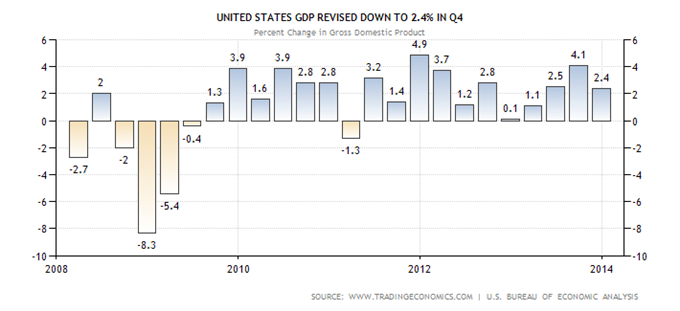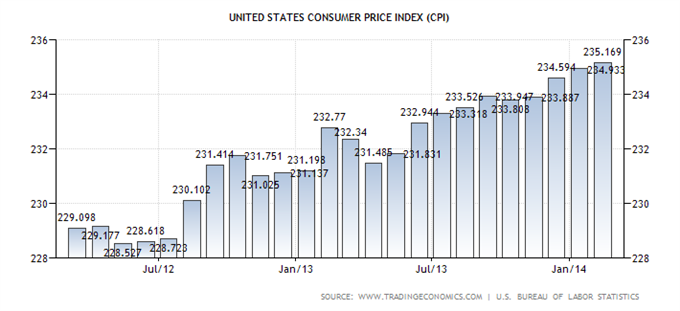Talking Points:
- News events can help us decipher an economy’s strength
- GDP, CPI and Employment figures can change the demand of a currency
- Fundamental traders look to pair currencies from a strong economy to a weaker one
There are a variety of news events fundamental traders may monitor to determine the strength or weakness of an economy. Ultimately, these factors will influence money flows causing currency pairs to fluctuate. Today we will continue our look at market fundamentals by examining three of the most important events and how they can affect currency prices.
GDP
Fist we have the Gross Domestic Product (GDP). The GDP growth rate looks specifically at changes in growth patterns of an economy by tabulating household consumption, government spending, domestic investment’s, and net exports for a country. As growth increases it means an economy is expanding and can cause a high demand for a nation’s currency as that currency is needed to make new purchases. As well a contraction or slowdown in growth can have the opposite effect.
Ultimately this growth (or lack of it) causes inflationary pressures in the market place. With central banks looking to potentially change monetary policy due to these results GDP announcements can become volatile events.
Learn Forex: US GDP

CPI
Next, we will look at the Consumer Price Index (CPI). CPI is another economic indicator that is released on a monthly basis by most major economies. It is designed to give a timely glimpse into current inflation levels in an economy. Inflation tracked through CPI looks specifically at purchasing power and the rise of prices of goods and services. If prices are raising drastically this can be signs of growth as well as rising inflation.
In most scenarios, if CPI is released lower than expected, normally this would influence Reserve Banks to consider stimulating the economy by opting for lower interest rates or commit to new open market operations to increase the money supply. Conversely a higher CPI reading suggests an inflating economy. This would give cause for increasing current interest rates and thus affect demand for a currency.
Learn Forex: US CPI

Employment Figures
Lastly fundamental traders should monitor employment figures to get a bearing on the strength or weakness of an underlying economy. A booming economy will offer many employment opportunities and drive down unemployment figures. As business contracts, the opposite is true. As unemployment rises, it can have a devastating effect on an underlying economy.
While there are a variety of employment statistics that can be tracked one of the most watched is the Non Farm Payroll (NFP) figure released in the United States. This event shows new jobs added to the workforce outside of the agricultural sector and shows the strength of the US economy. As this number is released fundamental traders will watch for opportunities to buy or sell currencies coupled with the dollar.
Now that you are familiar with some of the markets preeminent news releases you can begin following them while looking for trading opportunities. To practice pairing the strongest and weakest currencies register for a Free Forex Demo account with FXCM
This will conclude the 4th installment of the Forex Guide to Fundamentals! If you missed one of the previous editions, please enjoy the articles linked below.
The Forex Guide to Fundamentals, Part3: Central Banks
The Forex Guide to Fundamentals, Part2: Capital Flows & Interest Rates
The Forex Guide to Fundamentals, Part1: What is a Fundamental?
---Written by Walker England, Trading Instructor
To contact Walker, email instructor@dailyfx.com. Follow me on Twitter at @WEnglandFX.
To be added to Walker’s e-mail distribution list, CLICK HERE and enter in your email information
New to the FX market? Save hours in figuring out what FOREX trading is all about. Take this free 20 minute “New to FX” course presented by DailyFX Education. In the course, you will learn about the basics of a FOREX transaction, what leverage is, and how to determine an appropriate amount of leverage for your trading.
Register HERE to start your FOREX learning now!




